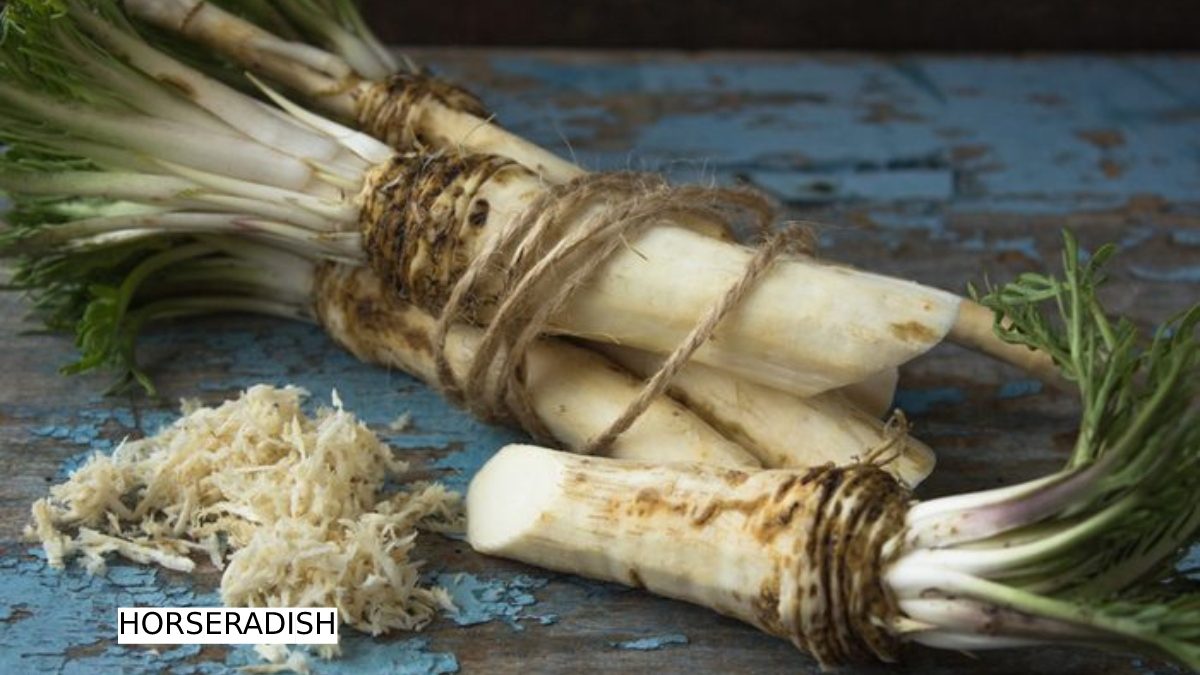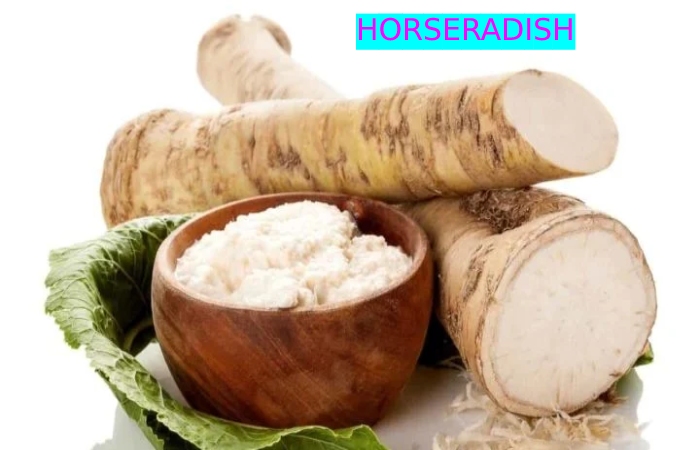Table of Contents
Horseradish- Meaning
Horseradish packs a bite. It is a condiment, both by itself and an ingredient in sauces and bandages. Prepared horseradish is voluntarily available at the grocery store, but you can make your own. You need to follow specific steps, so you don’t have to run from the kitchen due to the pungent odour suddenly.
Horseradish is a root vegetable, and an associate of the Brassicaceae family improved identified as the mustard family. Other mutual vegetables since this family include
Broccoli
Cauliflower
Cabbage
Brussel sprouts
Mustard greens
Wasabi
Kale
They’re also known as cruciferous vegetables. The horseradish plant is most often full-grown for its tapered root, which is large and white.
Horseradish is a condiment complete from the large, snowy root of the horseradish plant, which is in the same family as mustard and wasabi; it is a cousin of broccoli, cauliflower, and Brussel sprouts. The greeneries are also palatable. It can be full-grown in your garden as a recurrent in resoluteness zones 2 through 9. The root to use as culinary horseradish and offsets for the following year’s crop. The grated root can be rummage-sale fresh, or it can be dried or ground. You will frequently find horseradish added to condiments such as mustard or mayonnaise to advance them an extra bite. Horseradish sauce may be grated horseradish in vinegar, or it can be a creamy version.
Origins in Horseradish
Horseradish is natural to Russia and Hungary and has grown throughout verified history. Mentions in Greek mythology, Pliny’s “Natural History,” and Shakespeare.
Horseradish Taste Like
Isothiocyanate is the compound that gives off heat when exposed by eating or crushing horseradish. The volatile mustard-like oil in horseradish carries tears to the eyes and warmth to the tongue. Vinegar neutralizes the reaction and stabilizes the flavour. It should be added immediately to freshly grated horseradish to produce a milder taste.
Cooking with Horseradish
Horseradish is at its best and most flavourful when freshly grated. There are bottled changes, but grating it on your own will be more pleasing for your palate. Horseradish can by hand, but it is almost effortless with a food processor. The heat and fumes rapidly deteriorate like mustard once the horseradish or grated and exposed to air. In cooked dishes, horseradish is extra at the end of cooking as heat eliminates both the root’s aroma and zing.
Recipes with Horseradish
Horseradish is versatile and can for meat and vegetable dishes—fresh or a creamy horseradish sauce as a condiment for steak or prime rib. Chrain, a plant and dressing, is the traditional supplement to gefilte fish. Complement horseradish to make amazing deviled eggs. Spicy vegetable salad, and homemade mayonnaise that has a great kick. You’ll also need prepared if you make a bloody mary cocktail.
Devilled Eggs with Horseradish Sauce
Horseradish Mayonnaise
Dill and Horseradish Potato Salad
Buy a Horseradish
Horseradish is available year-round in most seats in the United States but during spring harvest season. Although the skin is white, the source is thin, brown skin. The fresh roots are in 2-inch long units and the produce section.
The roots are typically an inch or so in diameter, and when not cut into units, they can be several inches long with a bulb-like end. When buying roots, select those that are firm, not soft. The seeds should not show signs of meld or have green spots. Sources that appear dry or shrivelled are not ideal either.
Make Your Own Prepared
To make a ready to use as a condiment. You need a food computer or blender, vegetable peeler, knife, root, white vinegar, and salt. An airtight glass storage ampule is preferred if you are not using it directly.
Before you start, type sure you open up some spaces to create a source of freshening; when you begin to cut into the root. the smell can take over.
Peel the root. If using a hand grater, expurgated the piece in half lengthways. If using a food computer or blender, cut it into dice.
Pulse the to your desired consistency in a blender or food processor. The more delicate the surface, the more robust the will be. If using an indicator grater, grate the. Rough is when the strong odour kicks into high gear, so be ready.
Add vinegar and salt to taste. The extensive you wait to add the vinegar, the hotter and more vital the will be. Please don’t wait too long as grated root will quickly turn bitter unless miscellaneous with vinegar.
Store the prepared in the icebox for up to six weeks.
Storage
Store root dirty in a plastic bag in the refrigerator’s vegetable drawer. Use it within a workweek or two as the cut source will dry up. Grated should be used inside a few days or frozen for up to six months. Freezing the unprocessed meat is not recommended.
If you have added vinegar to the exasperated, you keep it in the refrigerator for up to six weeks. Bottled ready will last up to three months in the fridge. However, it quickly loses force and is best used within three to four weeks. It should be when it turns dark recommended.
Benefits
One of the most significant benefits is that it adds a large burst of flavour with very few calories and very little fat.1 There are about two calories in one teaspoon of prepared.
Horseradish Measurements & Substitutions
- one tablespoon grated fresh = two tablespoons bottled prepared
-
Uses
It’s rich in several essential nutrients, including:
Calcium
Dietary fibre
Folate
Manganese
Magnesium
Potassium
Vitamin C
Zinc
Supposed health benefits go back thousands of ages. You can find claims online—some supported by therapeutic science and some not.
Prevent cancer
Strengthen your immune system
Treat urinary tract infections
Treat sinus infections
Relieve pain and inflammation
Regulate your blood pressure
Acid indigestion
Recover the health of your teeth
Improve your metabolism
As with most extras, there’s not much evidence to back the claims out there. Though, some preliminary evidence supports some of the purported uses. Possibly the best-researched aspect is a component of the plant called sinigrin.
Conclusion
This is a rich basis of folate, also identified as folic acid. Just about anyone who’s contemplated pregnancy has caught that a diet high in folic acid can help stop a severe congenital disability.
Mustard oil can be exasperating and even toxic. Based on a trickle of animal studies in the 1980s and 90s believe that can cause a failure if used regularly or in large amounts.
Through breastmilk in levels high sufficient to be dangerous to your baby, for breastfeeding mothers.
It is “natural,” but it’s important to recollect that “all-natural” things can have potentially harmful effects. Any material that alters how your body functions, including supplements, can be considered a drug, and you should treat them like you would pharmaceuticals.
Be sure to let your healthcare provider or healthcare professional know about the extras you’re taking. That way, they can help you watch out for side effects, drug interactions, or any other potential problems.


